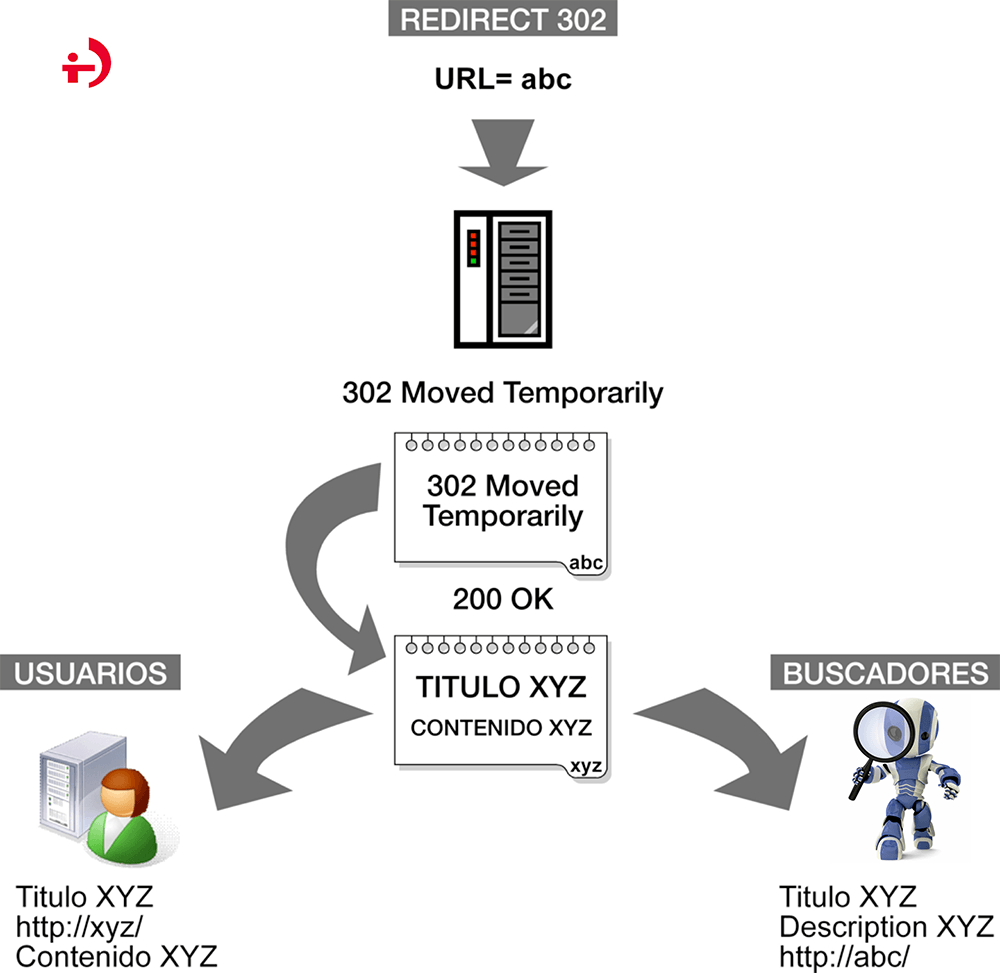Written by Anastasia Kurmakaeva
What is a 302 redirection?
A 302 redirection indicates that the content of a page has been temporarily moved to another URL and redirects requests from the original URL to the redirect destination.
In SEO, the 302 temporary redirection is used in very specific scenarios, in which it is necessary to redirect access from one content to another only temporarily, without involving a complete migration. This temporality is the main difference between a 302 redirection and a 301 redirection, recommended for definitive migrations.

As we can see in the graph, for users there is no difference between a permanent 301 redirection and a temporary 302 redirection. In both cases they perceive that the initially requested URL (abc) “jumps” to another one (xyz) where they finally access the content.
Search engine robots are also redirected from the original URL (abc) to the redirect target URL (xyz). However, the 302 temporality code will tell them that the URL under which they should index that content is the source (i.e., abc), not the destination (xyz). This is the main difference between a 301 and a 302 redirection. In the case of a 301 redirection, search engines will interpret that the content has migrated permanently to the destination address and will use this URL for indexing (in this case, xyz).
For practical purposes, a user does not notice the difference between a 302 and a 301 redirection. A search engine, on the other hand, interprets a 302 redirection literally: the transfer is temporary, and therefore, it is understood that the original URL is the one that must be kept indexed and positioned, because in the short or medium term it will be used again, and any authority and link juice it has previously achieved is not transferred to the URL receiving the redirect.The original URL is expected to be reestablished in the near future.
The current controversy with the use of 302 redirections is that they are often not used correctly, which ends up confusing search engines. We have known many cases in which the correct redirect would be 301, since the content has been moved to another route for good. And yet a 302 response code has been used instead, thus preventing the proper transmission of popularity and relevance to the new page, and the old URL from being successfully replaced by the new one in the search results.
Attention: we must be very careful with 302 redirections because only one URL can point to another with this type of redirect. If we redirect from multiple URLs with 302 redirections to another URL, we would be telling Google to index the content of the redirect destination URL with the multiple source URLs which would ultimately lead to a duplicate content situation.
When does it make sense to use a 302 redirection?
Using 302 redirections is recommended only in very specific cases, because a temporary transfer of content is not very common. Normally the redirection is made effective in a definitive way with its corresponding content migration, since it supposes a considerable alteration for the page, and it is something that you want to mitigate as much as possible, so as not to dizzy neither the users nor the search engines, with the consequent impact on the visibility and popularity.
We can think of the following possible scenarios:
- For a content already published and positioned, which is under construction or editing, for example, and we do not want users or search engines to have access to it while it is in that state. Access to the original URL will be restored once the changes have been completed.
- For usability, when due to some technical problem a content needs to be restored, and we do not want this problem to affect our users, or that they find themselves with a 404 error without knowing where to go. In this case we implement a temporary redirect and remove it once everything is fixed.
In short, the use of 302 redirections is not very common, and there are very good reasons for this. If in doubt, consult with a search engine optimization professional when moving content from your website, especially if it already enjoys good rankings in the results.
